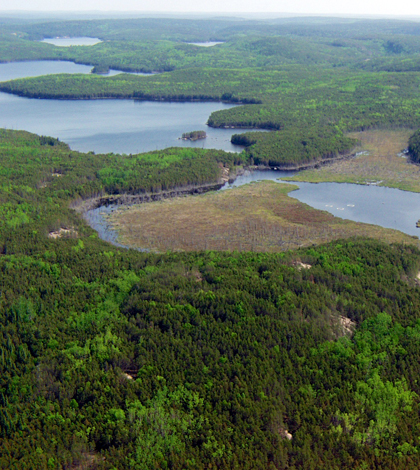Canada’s unique whole lake experimentation facility bounces back from funding cuts

A small wetland pond in the Experimental Lakes Area where a study demonstrated the increased production of greenhouse gases and methyl mercury caused by flooding wetland areas upstream of hydro-electric dams. (Credit: John Shearer)
A unique research facility in Ontario that’s home to 50 whole lake ecosystem experiments almost closed this year as the Canadian federal government cut funding for the facility.
“Our research has really slowed down during the last year and a half over the imminent threat that the government of Canada was going to close down ELA,” said Michael Paterson, interim director of the Experimental Lakes Area who worked as a researcher there for 21 years.
This September, two Canadian provincial governments prevented the limnological research facility from closing for good. Ontario’s provincial government will fund the area with $2 million per year. The provincial government of Manitoba will add $900,000 to the pot during the next six years.
The funding revived a quickly dying research area, unique in its ability to experiment on entire pristine lakes and their surrounding ecosystems. “It would be very, very difficult to start another facility like this from scratch,” said Paterson.
Wally E. Johnson and Jack R. Vallentyne opened ELA in 1968 to research eutrophication and acid rain. The facility sits two hours from any established towns where researchers can conduct experiments on entire pristine lakes and their surrounding land without affecting humans. No public cars are permitted to drive through roads in the area. Tourists hike or canoe in.
Paterson said there is a huge value to conducting experiments on entire lakes. He said one of the many unique advantages ELA offers is the ability to examine a human-induced pollution event from start to finish. “There’s often an absence of pre-impact data for affected systems,” he said.

A Hughes 500 chopper picking up a sling of concentrated sulphuric acid for a study on the effects of acid rain on lake ecosystems. (Credit: John Shearer)
Of the Experimental Lakes Area’s 58 lakes, the largest is 170 acres. All were untouched until researchers started experimenting on the lakes and the surrounding land. Research there focuses on problems facing lakes across the world.
Typically, the experiments start with monitoring an unaltered lake for several years prior to making any changes. Scientists test their experiments in the lab and mesocosms to examine some possible results. Then the alterations begin.
Experimental Lakes Area researchers have been conducting an experiment on eutrophication on one of the facility’s lake for 45 years. “Essentially, we’ve varied amounts of nitrogen and phosphorus that we’ve added to the lake,” Paterson said.

While most biological activity slows down in the frigid darkness under ice and snow cover on these lakes, there is still useful information to be gained from occasional sampling during these winter periods.
Researchers at the facility have also examined the effects of acidification on a lake ecosystem. Paterson said that research involved pouring sulfuric acid into one of the area’s lakes. For a study on mercury pollution, a crop duster sprayed the heavy metal over a lake.
One of the latest pollutants researchers are studying is nanosilver used in antibacterial compounds in many consumer products.
While experimentation will now continue the way ELA does business will have to change. Paterson said researchers will have to spend more time seeking funding similar to university researchers.

Technician Ken Sandilands and a student assistant sampling zooplankton using a double-barrelled net sampler. All key components of the ecosystem are monitored, both in manipulated systems and in nearby natural reference systems.
In the meantime, Paterson is focused on moving ELA back toward full operation under funding from Ontario and Manitoba. “I am optimistic that the transfer will happen and be successful,” he said.
Top image: A small wetland pond in the Experimental Lakes Area where a study demonstrated the increased production of greenhouse gases and methyl mercury caused by flooding wetland areas upstream of hydro-electric dams. (Credit: John Shearer)




0 comments